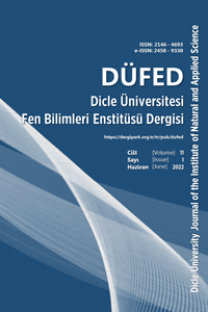Farklı Nüve Malzemelerinin Transformatörün Verimi Üzerindeki Etkilerinin Analizi
Analysis of the Effects of Different Core Materials on Transformer Efficiency
Transformer, Magnetic field, Core material FEM,
___
- T. Zupan, B. Trkulja, R. Obrist, T. Franz, B. Cranganu-Cretu, and J. Smajic. ‘‘Transformer windings rlc parameters calculation and lightning impulse voltage distribution simulation’’, IEEE Transactions on Magnetics, vol.52, no.3, pp.1-4, March 2016.
- T. Zheng, Y.J. Zhao, J. Ying, P.L. Chen, F.F. Zhang “Design and analysis on the turn-to-turn fault protection scheme for the control winding of a magnetically controlled shunt reactor”, IEEE Transactions, vol. 30, no.2, pp. 967-975, 2015.
- M. Yazdani-Asrami, M. Mirzaie, A.S. Akmal, No-load loss calculation of distribution transformers supplied by nonsinusoidal voltage using three-dimensional finite element analysis, Energy, vol. 50, no. 1, pp. 205-219, 2013.
- M. Ostrenko and B. Andriienko, "Transformer impulse surges calculation by FEM coupled to circuit," in IEEE Transactions on Magnetics, vol. 53, no. 6, pp. 1-4, June 2017, Art no. 7401804.
- T. Zheng, Y.J. Zhao, J. Ying, P.L. Chen, F.F. Zhang, “Design and analysis on the turn-to-turn fault protection scheme for the control winding of a magnetically controlled shunt reactor”, IEEE Transactions, vol. 30, no.2, pp.967-975, 2015.
- B. Qi, X. Zhao, C. Li, H. Wu, Transient electric field characteristics in oil-pressboard composite insulation under voltage polarity reversal. IEEE Trans. Dielectr. Electr. Insul., vol. 22, pp. 2148–2155, 2015.
- Y. Özüpak, M. S. Mamıs, Realization of electromagnetic flux and thermal analyses of transformers by finite element method. IEEJ Transactions on Electrical and Electronic Engineering, vol.14, no.10, pp. 1478-1484. Doi: 10.1002/tee.22966, 2019.
- Y. Özüpak, M. S. Mamıs, İ. H. Teke, ‘‘Electromagnetic Field and Total Loss Analysis of Transformers by Finite Element Method.’’ International Journal of Engineering And Computer Science, vol.8, no.1, pp. 24451-24460. Yayın No: 5774086, 2019.
- P. Huang, C. Mao, D. Wang, ‘‘Electric Field Simulations and Analysis for High Voltage High Power Medium Frequency Transformer’’ Energies, vol.10, no.3, pp.371, doi:10.3390/en10030371, 2017.
- M. Ostrenko, B. Andriienko, "Transformer impulse surges calculation by FEM coupled to circuit," in IEEE Transactions on Magnetics, vol. 53, no. 6, pp. 1-4, June 2017. Art no. 7401804.
- K. Sarpreet, K. Damanjeet, Analysis of effect of core material on the performance of single phase transformer using FEM, IOP Conf. Series: Materials Science and Engineering 561, 012129, 2019. doi:10.1088/1757-899X/561/1/012129
- A. Lotfi, M. Faridi, 2012. Design optimization of gapped-core shunt reactor”. IEEE, vol. 48, no.4, pp.1673-1676
- P. Beckley, Electrical steels for rotating machines, No. 37, IET, 2002.
- M. Zare, S.M.P. Razi, H.F. Farahani and A. Khodakarami, Finite Element Analysis of Leakage Inductance of 3-Phase Shell-Type and Core Type Transformers. Research Journal of Applied Sciences, Engineering and Technology, vol. 4, no. 12, pp.1721-1728. 2012.
- ISSN: 2146-4693
- Yayın Aralığı: Yılda 2 Sayı
- Başlangıç: 2012
- Yayıncı: Dicle Üniversitesi
Farklı Nüve Malzemelerinin Transformatörün Verimi Üzerindeki Etkilerinin Analizi
Durum Buğday Çeşit, İleri Hat ve Yerel Popülasyonlarının Kalite Özelliklerinin Değerlendirilmesi
Sertaç TEKDAL, Mehmet YILDIRIM
Yem Bezelyesi Tarımı ve GAP Pembesi Yem Bezelyesi Çeşidinin Önemli Tarımsal Özellikleri
Adil UMAZ, Fırat AYDIN, Mehmet FIRAT, Abdulselam ERTAŞ
Silindirle Sıkıştırılmış Betonlarda Su/Çimento Oranının Etkileri
İsmail KILIÇ, Saadet Gökçe GÖK
Organotipik Beyin Kesitleri Kullanımının Nörobiyolojik Çalışmalardaki Yeri
Elif MUTLU, Hasan H.s. ABUIYADA
Diyarbakır Şartlarında Bazı Kendilenmiş Mısır Hatlarının Değerlendirilmesi
